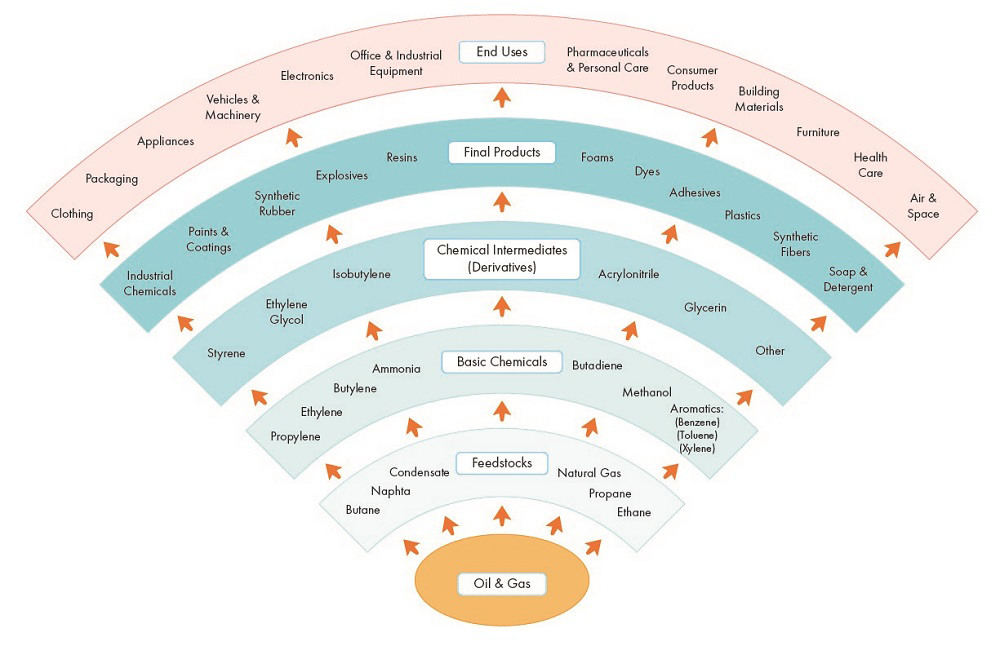Market Snapshot: Petrochemical products in everyday life
Release date: 2018-10-17
A myriad of objects we use daily are made of petrochemicals.Footnote 1 Petrochemical products include plastics, rubbers, resins, synthetic fibers, adhesives, dyes, detergents, pesticides, and petroleum-derived paints and coatings. In 2016, petrochemicals accounted for approximately one third of the 1.1 million barrels per day of the natural gas liquidsFootnote 2 demand in Canada.
Petrochemical products are manufactured from raw materials (oil and natural gas) to feedstocks, basic chemicals, chemical intermediates (derivatives), and ultimately final products. The number of products grows from less than fifteen basic petrochemicals to thousands of final products as illustrated in the flow chart below.
The Petrochemical Products Flow Chart

Source and Description
Source: U.S. Department of Energy, Oil and Gas Info, IHS, ICIS, NEB
Description: This diagram illustrates the petrochemical products flow from raw materials (oil and natural gas) to feedstocks, basic chemicals, chemical intermediates (derivatives), final products, and end uses of petrochemical products in industrial and consumer goods.
Canada is an important petrochemical producer on a global basis, due to its abundant natural gas and oil resources. A way to measure the size of a country’s petrochemical industry is the installed capacity to manufacture ethylene, the most produced basic petrochemical in the world. In 2015, Canada had the world’s seventh largest ethylene production capacity after the U.S., China, Saudi Arabia, Japan, Germany, and South Korea. Canada also has the second largest ethylene complex in the world, located in Joffre, Alberta.Footnote 3 In 2017, the Canadian production of petrochemicals and related productsFootnote 4 was valued at more than $19.4 billion.
Share of Ethylene Producing Capacity by Country in 2015

Source and Description
Source: Oil & Gas Journal (OGJ)
Description: This pie chart shows the share of the world ethylene producing capacity by country in 2015. The U.S. has the largest share of ethylene producing capacity in the world (20%), followed by China (10%), Saudi Arabia (9%), Japan (5%), Germany (4%), South Korea (4%), and Canada (4%).
Petrochemicals have multiple applications in consumer and industrial products and a number of them have well known trade names. For example, Plexiglas is used extensively instead of glass in cars, airplanes, aquariums, and household appliances. Teflon is widely used in non-stick pans, but is also used in chemical-proof pipes, medical injection tubes, and microelectronics because of its resistance to extreme temperatures and acids. Gore-Tex, a breathable, waterproof textile used in outdoor clothing such as hiking boots and mountain coats, is a Teflon-treated polymer. Kevlar is a synthetic fiber that is five times stronger than steel, and does not corrode or rust. Kevlar is used in bulletproof vests, parachutes and in composite materials used in aircrafts and boats. In 1938, Nylon was developed as a substitute for silk and today it is used in stockings, parachutes, ropes, bridal veils, and guitar strings. Homes and offices also make extensive use of petrochemicals as illustrated in the figure below.
Petrochemicals at Home

Source and Description
Source: U.S. Department of Energy, Oil and Gas Info, IHS
Description: This house diagram with pictures of different parts of a house (bathroom, living room, kitchen, home office, and bedroom) shows how common households equipment that contain petrochemical products.
Petrochemicals can have negative impacts on the environment and human health. Because of this, regulations in Canada and other countries control chemical substances to protect human health and the environment. Canada, the U.S. and other countries have also implemented regulations and programs to manage and reduce waste, including plastics and other hazardous materials.
- Date modified:
